
Andy Lloyd's Dark Star Blog

Blog 37 (April 2016)
Haystack Latest:
The Hunt for Planet Nine Goes On...
Academic papers aimed at further constraining the parameters of the purported 'Planet Nine' body continue to emerge from various quarters, many from researchers with long-term interests in outer solar system anomalies. Fairly quickly after Brown and Batygin's announcement about Planet Nine (1), a paper was published by A. Fienga et al examining the astrometry of Saturn through Cassini's radio ranging data (2). This work served to constrain the possible locations of Planet Nine, which were wide ranging to say the least. This is because if one can establish the very precise positioning of outer planets over time, then this can provide clues to any slight gravitational effect, or perturbation, the planet might be experiencing from an undiscovered distant substantial Planet X body (3).
However, given that Planet Nine is thought to have a highly elliptical orbit, then if it is located at the further end of that ellipse, its effect upon the outer planets gravitationally becomes vanishingly small. It turns out then, as one might predict, that we can rule out its current location being in the nearer half of its elliptical path, according to the Cassini data about Saturn. Which is more or less common sense, anyway.
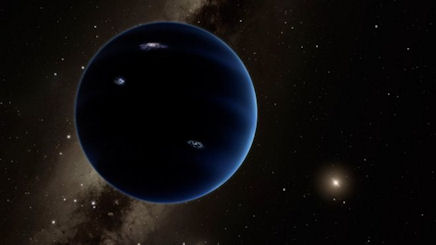
Now, new work has emerged on the astrometry of Pluto (4) and other Trans-Neptunian Objects. These objects are, evidently, located much further away from us than Saturn, and their more loosely bound orbits may provide fertile hunting ground for gravitational perturbation effects caused by an unknown body beyond. In this case, astrophysicists from the Harvard-Smithsonian Center for Astrophysics have come to an altogether different conclusion: this Planet Nine body is likely either larger than Brown's 'Super-Earth' object of 5-15 Earth-masses; or instead closer than he, or Fienga's team, concluded. In other words. this thing packs a bigger perturbing punch than first thought:
"Our best fits suggest a planet that is either more massive or closer than argued for by Batygin and Brown (2016) based on the orbital distribution of distant trans-neptunian objects (or by Fienga et al. (2016) [2] based on range measured to the Cassini spacecraft). The trend to favor larger and closer perturbing planets is driven by the residuals to the astrometry of Pluto, remeasured from photographic plates using modern stellar catalogs (Buie and Folkner 2015) [4], which show a clear trend in declination, over the course of two decades, that drive a preference for large perturbations. Although this trend may be the result of systematic errors of unknown origin in the observations, a possible resolution is that the declination trend may be due to perturbations from a body, additional to Planet Nine , that is closer to Pluto, but less massive than, Planet Nine." (5)
To be fair to Dr Brown, he had already built into his paper an allowance for a larger object (by "a factor of a few") (1), which I highlighted when his paper was first published online (6). For anyone familiar with my own writing down the years will know, it would not surprise me at all if this planet turned out to be very substantial in mass indeed, although this would then require it to move in an orbit far longer than even Dr Brown's 20,000+ years.
Another paper to emerge this month uses super-computer 'Monte Carlo' calculations to provide modelling of the effect upon the solar system from a series of Planet Nine positional and mass parameters (7). Results from these theoretical tests provide the Spanish astronomers with the most likely zones in the sky to search for the proposed planet; although the authors of the paper strike a note of caution about some of the data Drs Brown and Batygin have based their work upon. At the moment, it is not clear whether there is any significant cross-over between all these studies in terms of a common focus for this search.

Here's a summary of the four areas of the sky favoured by the authors of this paper for the location of Planet Nine, including how they compare these results to those of Drs Brown and Batygin's work (1) and that of Dr Fienga et al (2):
Most probably Hydra, away from the main bulk of the Milky Way,1)
2)
Equally probably between Scorpius and Lupus, towards the Galactic bulge, but relatively far from the galactic centre. These first two are the most probable, say the authors, but have values inconsistent with the 'pseudo resonant scenario' described by Brown and Batygin (1)3)
Less probable, they say, is Taurus, a calculation which uses values favoured by Brown and Batygin, and also Fienga et al, and is also consistent with apsidal anti-alignment. (A similar Monte Carlo approach to Fienga's values additionally provides the constellation of Cetus)4)
Least likely, between Microscopium and Sagittarius (7)Once again, I seem to be backing the outsider, with Microscopium and Sagittarius at long-odds! I suspect we have some way to go before these dark horses enter their final furlong.
An additional paper to emerge from Harvard also takes a look at the Cassini radio ranging data, but instead of focussing simply on the most-favoured parameters published by Brown and Batygin for their Planet Nine (1), as Fienga et al did (2), Holman and Payne explore possible correlations between the Cassini data and a broader range of values for Planet Nine's possible orbit (8). As a result of a theoretical model they developed to analyse this spread of possible values, they argue that they have been able to significantly constrain the parameters for Planet Nine's orbit, and predict an area of the sky within which Planet nine might currently reside:
"Our preferred region is approximately centered on (RA, Dec) = (40◦, −15◦), extending ∼ 20◦ in all directions... It is clear that the preferred range of RA & Dec is strongly restricted. You should go and search there." (8)
This correlates to an area centred around a point located between the constellations of Eridanus and Cetus. This sky zone again correlates well with Monte Carlo calculations based upon Fienga's values (see point 3, above). However, the area of the sky to be searched remains 'thousands of times larger than the full Moon" (9), which is obviously still quite a challenge. Sky searches like the Dark Energy Survey are getting involved, as they are already obtaining and crunching data for this extensive area of the sky (9).
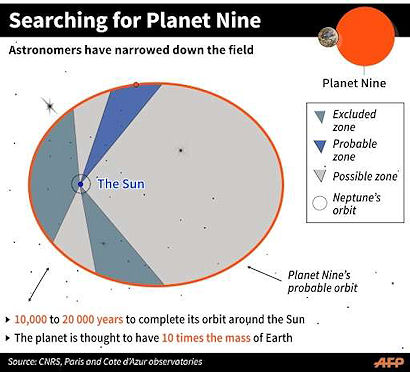
On top of all of the frenzied work being carried out to narrow the search down, hypotheses are also being considered to explain how Planet Nine ended up where it is (or at least, where it's purported to be) (10). Ideas include migrating gas giant remnants (1), a captured exoplanet from a passing star (11), or gradual accretion of diffuse material in the outer solar system (12). Additionally, exoplanet experts from the University of Bern in Switzerland, astrophysics professor Cristoph Mordasini and Ph.D. student Esther Linder, have modelled Planet Nine to provide some insight into what they think it might be composed of, as well as its various properties
"Their model reflects a very cold gas giant. It would be, as previously ascertained by the Caltech team, around 10 times Earth's mass, with a radius 3.7 times that of Earth's. Its temperature would be minus 226 degrees Celsius, or 47 Kelvin. Any radiation it emits would be dominated by its cooling core, which means it would be much brighter in infrared than visible light. This could help provide some clues to finding Planet Nine.
"As to why it hasn't been found yet, previous sky surveys only have a very small chance of spotting an object so far away if it is less than 20 Earth masses. NASA's Wide-field Infrared Survey Explorer could pick up such a planet, but only if it was 50 Earth masses or larger. "This puts an interesting upper mass limit for the planet," Linder said." (13)
Given the paucity of data, this all seems highly speculative, but does fairly reasonably follow the planetary models of 'ice giants' Uranus and Neptune, to provide us with an outer solar system planet which would be the runt of this ice giant litter.
Image Credit: University of Bern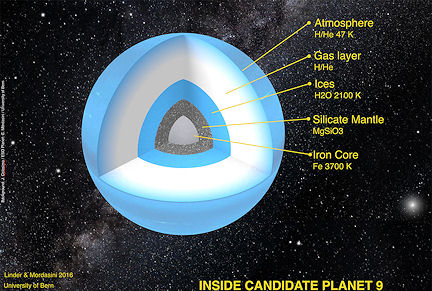
Using their planet evolution model, Mordasani and Linder calculated how parameters like the planetary radius or the brightness evolved over time since the Solar System formed 4.6 billion years ago (14), and how its relative magnitude might vary with size and distance from the Sun (15). How such an object might have evaded detection by an infra-red sky survey as powerful as WISE seems to be at the forefront of these planetary scientists' minds, and one can't help but think that the variable parameters have been cherry-picked to provide the scientific community with a best-fit scenario which hopes to get around this conundrum.
Written by Andy Lloyd, 5th-29th April 2016
References:
1) Konstantin Batygin & Michael Brown "Evidence for a Distant Giant Planet in the Solar System" The Astronomical Journal, 151: 2, 20 January 2016,
2) A. Fienga et al. "Constraints on the location of a possible 9th planet derived from the Cassini data" Astronomy and Astrophysics Letters, 587, March 2016
3) Jonathan O'Callaghan "Where Is Planet Nine?" 25 February 2016,
4) M. W. Buie and W. M. Folkner. "Astrometry of Pluto from 1930-1951 Observations: the Lampland Plate 17 Collection", The Astronomical Journal, 149: 22, Jan. 2015
5) Matthew Holman and Matthew Payne "Observational Constraints on Planet Nine: Astrometry of Pluto and Other Trans-Neptunian Objects" The Astronomical Journal, 152: 4, 30 Mar 2016,
6) Andy Lloyd "Massive Planet X Now Urgently Sought by Top Planet-Hunters" 20-23 January 2016
andylloyd.org/darkstarblog34.htm
7) C. de la Fuente Marcos & R. de la Fuente Marcos "Finding Planet Nine: a Monte Carlo Approach" Monthly Notices of the Royal Astronomical Society: Letters, 459: 1, L66–L70, 11 June 2016, thanks to Eitan
8) Matthew Holman & Matthew Payne "Observational Constraints on Planet Nine: Cassini Range Observations" The Astronomical Journal, 152: 4, 12th April 2016
9) Shannon Hall "We are closing in on possible whereabouts of Planet Nine" 20 April 2016,
10) Shannon Hall "Planet Nine might be an exoplanet stolen by the Sun" 4 April 2016, with thanks to Lee
11) Alexander Mustill et al. "Is there an exoplanet in the Solar System?" Monthly Notices of the Royal Astronomical Society: Letters, 460:1, L109–L113, 21 July 2016,
12) Scott Kenyon et al. "Making Planet Nine: Pebble Accretion at 250--750 AU in a Gravitationally Unstable Ring", The Astrophysical Journal, 825: 33, 1 July 2016
13) Michelle Starr "Is this what Planet Nine looks like?" 8 April 2016, with thanks to Mark
14) Paul Rincon "Planet Nine's profile fleshed out" 10 April 2016
15) Esther Linder & Christoph Mordasini "Evolution and Magnitudes of Candidate Planet Nine", Astronomy and Astrophysics, 589: A134, May 2016
Young Free-Floating Worlds
A very young example of a 'dark star' has been discovered floating free of any parent star some 95 light years away. This object, known as 2MASS J1119-1137, is thought to weigh in between 4 and 8 times the mass of Jupiter, and is at the moment relatively bright in infra-red due to its extremely young age. Some detective work was required by astronomers to help differentiate this object from more distant red dwarf stars, but it has not been recognised as being a member of a cluster of very young stars within our cosmic neighbourhood, known as the TW Hydrae association (1,2).
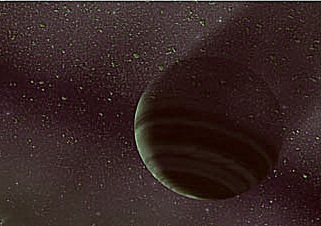
This range of masses is similar to what I think a companion object of our Sun might be, although 2MASS J1119-1137 is practically a neo-nate compared with our own elderly dark star Planet X object. This makes a huge difference, because objects of this size are capable of emitting quite a bit of light and heat in their early phases, before quickly burning up what scant nuclear fuels they have available. They are effectively 'light-emitting planets' for a short while. After this, they die right back to become smouldering versions of their youthful brashness, and hence become much, much more difficult to detect.
There's another consideration I want to add to this, building upon work I've been doing over the last year or so (3,4). Light-emitting planets will also be spewing out all kinds of other by-products of the stellar processes, like coronal mass ejections, charged plasma, and so on. In other words, during this active phase, these free-floating worlds will be acting like mini-stars, and will be creating around them an area of outward, positive pressure akin to our Sun's own solar wind - only on a lesser scale. This effect drives away material, but for only a short time. Once the light goes out, these free-floaters become more like smouldering versions of Jupiter, and although they will continue to have very significant magnetic fields and some occasional flaring activity, the solar wind-style effect will be largely lost.
My recent arguments about such objects in interstellar space is that they should then continue to attract to themselves (through the process of accretion) further interstellar materials they encounter as they move through the galaxy. I argue, then, that they become wrapped up in clouds of gas and dust - as well as the formation of disks, rings and moons - forming a complex cloaking dark nebula, which makes them even more difficult to detect as they get progressively older (5).
I've been trying to pitch these ideas to academic astrophysicists, with little success to report to date, I'm afraid. I think they read what I write to them, but replies are very rare indeed. I have no way of knowing, then, whether this idea might have any significant traction. If it does, then there are a number of potential ideas about the nature of Nibiru which might run on from this. These ideas I will be presenting at various conferences I'm speaking at over the next few months, prior to future inclusion in this blog.
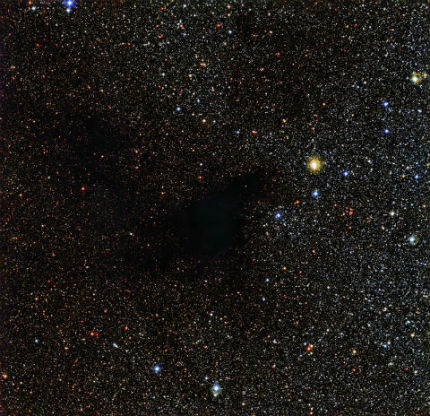
In the meantime, scientists are using the Kepler Space Telescope to search for more of these free-floating worlds. Ground-based telescopes survey the sky in the hope to discover microlensing effects, where a star's brightness might vary because of the movement of another cosmic body between that star and us. However, it's difficult to decide whether such an event really is due to the existence of such a dark, unseen body, or whether it might be due to other factors, like stellar flares or a natural variability in a star's brightness.
Bringing the K2 space telescope to bear on these events will provide a secondary perspective which should allow astronomers to determine the occasions when a free-floating dark world (of Saturn and Jupiter size) has moved through the field of view (6). This ongoing work over the next few months should provide a more reliable picture about the prevalence of free-floating planets and Dark Stars in the galaxy.
Written by Andy Lloyd,
12th February 2016
References:
1) Amy Middleton “Bright, young Jupiter-like ‘orphan’ found floating nearby” 11 April 2016
2) Carnegie Institute press release "Young-unattached-jupiter-analog-found-solar-neighborhood" 6 April 2016
3) Andy Lloyd "The Shroud Hypothesis" 12 January 2015
andylloyd.org/darkstarblog22.htm
4) Andy Lloyd "The Cumulative Effect of Intermittent Interstellar Medium Inundation Upon Objects In The Outer Solar System" Feb 2016, DOI: 10.13140/RG.2.1.5112.5526 - an updated version (22/2/16) is available here:
5) Andy Lloyd "The Shroud Hypothesis as part of a Dark Star Solution" 9 February 2016
andylloyd.org/darkstarblog35.htm
6) Irene Klotz "Kepler's New Mission: To Hunt Strange Orphan Worlds" 9 April 2016, with thanks to Lee
Early Solar System Catastrophism
The two moons of Mars have always presented planetary scientists with something of a mystery. These tiny moons, Phobos and Deimos, whizz around Mars at no great height at all: Phobos whips around the red planet in less than 8 hours, at a height of only 3,700 miles - the closest of any moon to its parent planet. I say 'parent' advisedly, because a new theory of the origin of these peculiar little moons suggests that they emerged from a major impact between mars and a dwarf planet. It has generally been assumed that they were captured asteroids, but the relative circularity of their orbits argued against such a capture.
Work on the possibility of a catastrophic origin was carried out last year by two separate teams of researchers, after decades of battling intense scepticism within the scientific community (1). An important finding of the modelling at that time was that the resultant debris would circulate around the red planet at a relatively low altitude, which is in keeping with the orbits of the two extant moons.
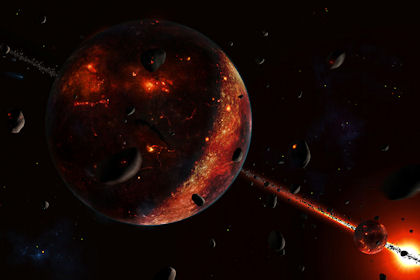
More recently, further computer modelling of various impact scenarios carried out by one of those teams has narrowed down the range of masses of an impactor to about the size of Pluto. The resultant debris field was initially far more extensive than the two moons left today:
"The results show that [an impacting object with roughly the mass of Pluto] would throw around a thousandth of Mars's mass into orbit, and the edge of the disc would reach beyond the 24,000-kilometre orbit of Deimos, the outer moon. Over time, the material nearer to Mars would coalesce into large bodies, but the planets gravity would eventually drag them back down. But the outer part of the disk would spin fast enough to keep it out of gravitys clutches, and the material would form into the Phobos and Deimos we see today.
"The idea is that Phobos and Deimos are the only two survivors of a once much larger population of satellites,”says [Julien] Salmon [of the Southwest Research Institute], who presented the work at the Lunar and Planetary Science Conference in The Woodlands, Texas, last month. Such a large object hitting Mars in its past could also explain some other features we see today, like the planet's relatively fast rotation and the large differences in average surface height between its northern and southern hemisphere, says Salmon. “It makes sense to think about a big impact for Mars."" (2)
I don't think anyone's going to be too surprised that during the early period of the solar system, planets like Mars could have been struck by substantial 'dwarf planets' during that turbulence.
For me, potentially the most interesting aspect of this would be the timing of such an event. If it occurred very early on, where the Mars was in a primordial, molten state, then this is no real news. However, Mars appears to have been killed at some point, and the most likely time period for such an event would have been during the late, heavy bombardment, a long period of on-going catastrophe between 3.9 and ~3.6 billion years ago. No one knows what caused this late period of immense destruction. It's become increasingly clear that the solar system's early history was exceptionally violent, perhaps even exceptionally so compared with other star systems.Dr Batygin, the dynamicist who worked with Dr Mike Brown on the Planet Nine paper in January (3), has published a new paper with other collaborators, and puts it like this:
"A wealth of new evidence from computer simulations as well as observations of planets throughout the galaxy is revealing new details of our solar system's dynamic and violent history.
The solar system's configuration of small inner rocky worlds and large outer giants is anomalous in comparison with most other planetary systems, which have different architectures.
The best explanation for the solar system's oddity is that the giant planets went through an extended sequence of orbital migrations and dynamical instabilities billions of years ago.
These tumultuous events could have sent entire planets tumbling into the sun or out to interstellar space and may have been crucial for the origins and earliest evolution of life on Earth." (4)
These statements turn the common conception that the solar system was once a 'normal', straightforward youngster on its head. On the contrary, astrophysicists look at our solar system's current configuration, which on the face of it seems so calm and well-structured, and see a past filled with widespread violence on a cosmic scale, major planetary migrations and complex reconfigurations before today's relative calm was achieved.
This is not news to catastrophists, like me. I consider it highly likely that a usurper planet, yet to be discovered in our outer solar system, played a major role in this, and that much of what Zecharia Sitchin wrote on the subject (5) has some truth to it. I think things went something like this: Up until 3.9 billion years ago, Nibiru/Marduk was a substantial companion object of the Sun well beyond the protoplanetary disk, safely out of the way (although perhaps, as researcher Barry Warmkessel has suggested, an intrinsically important element in the whole planet formation process (6)).
At the 3.9 Gyr point, something (a passing star?) caused Nibiru/Marduk to shift gears, and cruise through the planetary zone, causing the Celestial Battle Sitchin speaks about. That catastrophe created a chaotic environment, both for the inner planets, but also for this object itself. Things evidently eventually settled down into a steady state, but it seems that the late, heavy bombardment's longevity, of ~300 million years, offers us an opportunity to see an extended aftermath. It may have been during this period of repeated intrusions of Nibiru/Marduk through the planetary zone that the kind of impact that Mars suffered occurred. Hence why the timing of this is so crucial.
Where I part with Sitchin is that after 3.6 Gyr, the usurper clearly stopped causing this chaos and destruction. Therefore, it seems likely to me that its orbit shifted once again, perhaps by one of these catastrophic incursions, and it migrated out to a much safer distance, leaving the planetary zone of the solar system in relative peace from that point onwards. This is not Sitchin's view, of course, but I think it makes more sense of the facts as we know them.
A Captured Exoplanet?
My contention that Nibiru/Marduk was an original partner of the Sun (albeit initially in a very loosely bound, distant orbit) is based purely upon probability. It's difficult, but not impossible, to capture objects moving through interstellar space, and it just seems more likely to me that the Dark Star companion to the Sun was already on the scene at the beginning. But that is not the only possibility by any stretch of the imagination, as has been pointed out by my French researcher friend François Berguerand in correspondence we have recently shared on the subject.
In 2012, researchers from the Harvard-Smithsonian Center for Astrophysics in Cambridge, Mass., and Peking University in China, simulated young star clusters containing free-floating planets, and realised that it would not be as uncommon as one might imagination for stars to effectively swap planets between them (7).
Planets which are ejected by one star might be picked up by another within the tightly-knit cluster (which might contain thousands of young stars). These clusters spread out over time and, with as a result of this process, the likelihood of this 'planet-snatching' process taking place declines.
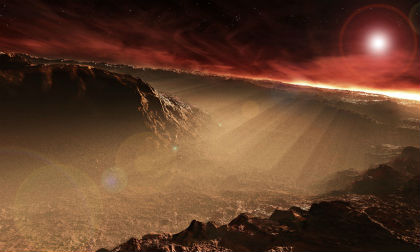
So, it's entirely possible that Nibiru/Marduk might have originated from a sister star within the Sun's birth cluster, and was effectively snatched away from her by our Sun. That would be in keeping with Sitchin's original hypothesis about the incursion of a rogue fiery planet travelling through interstellar space which becomes captured by the Sun into a highly elliptical orbit. Whether the timing of such an event is realistic as late as the Late, Heavy Bombardment, some 700 million years after the birth of the Sun, is a moot point, because the initial birth cluster would have been well on the way towards dissipation by that point. Birth clusters seem to retain their definition for about 100 million years.
As discussed in the first article in this blog, such a scenario might be applied to the Planet Nine object which has captured the imagination of the astronomical community this year. A team of astrophysicists - Drs Mustill (of the Lund Observatory in Sweden), Raymond and Davies - consider it perfectly plausible that the Sun might have captured the purported Planet Nine body from a sister star early on in the life of the birth cluster, and have conducted computer simulations to demonstrate how this might have occurred, under certain conditions:
"Any capture scenario must satisfy three conditions: the encounter must be more distant than ~150 au to avoid perturbing the Kuiper belt; the other star must have a wide-orbit planet (a>~100au); the planet must be captured onto an appropriate orbit to sculpt the orbital distribution of wide-orbit Solar System bodies." (8)
Even so, the odds of such a capture are low, they say (9), but certainly not impossible. Much of this speculation hangs upon the prevalence of interstellar free-floating worlds and Dark Stars, which remains an unknown quantity presently. The more of these objects there are in existence, the more likely it becomes that these wilder possibilities might have taken place.
The LHB and Mars
The Late, Heavy Bombardment features in other theories about the nature of early Mars, and what might have happened to it. We have delved into the mysteries of Martian water in previous blogs, and the probable existence of a sizeable northern ocean on the red planet at some point in the past. The chaotic tilt and orbital variance of Mars might play a significant role in terms of periodic melting of substantial bodies of underground ice (10). Furthermore, it is quite possible that liquid water existed on the Martian surface far more recently than is generally accepted, creating further riddles for scientists to ponder (11).
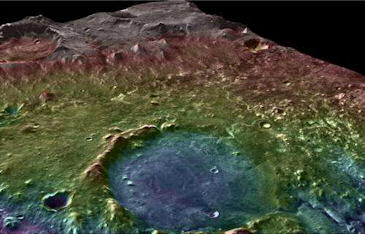
New work looking at the topography of likely ancient ocean shorelines has potentially added more detail to this debate, but remains contentious (12). Perhaps the early Martian surface was partially covered by a thin layer of ice, which was then bombarded by asteroids to evaporate away into and beyond the thin atmosphere of Mars. Or perhaps, a shallow ocean existed in aqueous form which succumbed to sublimation over a longer period of time, driving much of the early water of Mars away into space. Whatever the case, it seems likely that many mysteries of the solar system are tied up with the Late, Heavy Bombardment, whose origins remain unclear. I suggest that Zecharia Sitchin's ideas on this front were very much ahead of their time!
Written by Andy Lloyd,
18-28th January 2016
References:
1) Ken Croswell "Are Mars's moons homegrown—or snatched from the asteroid belt?" 19 May 2015
2) New Scientist "Mars moons may have formed after collision with Pluto-like world" 8 April 2016,
3) K. Batygin & M. Brown "Evidence for a Distant Giant Planet in the Solar System" The Astronomical Journal, 151: 2, 20 January 2016,
4) Konstantin Batygin et al. "The Violent Biography of Our Solar System" May 2016
scientificamerican.com article
5) Zecharia Sitchin "The Twelfth Planet" Avon, 1976
6) Correspondence from Barry Warmkessel on the Google Dark Star Planet X Forum, 15 April 2016
groups.google.com dark-star-planet-x post
7) Ian O'Neill "Thieving Stars Snatch Orphan Planets" 30 April 2012
8) Alexander Mustill et al. "Is there an exoplanet in the Solar System?" Monthly Notices of the Royal Astronomical Society: Letters, 460: 1, L109–L113, 21 July 2016
9) Shannon Hall "Planet Nine might be an exoplanet stolen by the Sun" 4 April 2016, with thanks to Lee
10) Andy Lloyd "The Implications of Mars' Chaotic Tilt" 22 March 2016
andylloyd.org/darkstarblog24.htm
11) Andy Lloyd "A Martian Riddle" 22 September 2014
andylloyd.org/darkstarblog18.htm
12) Elizabeth Howell "Did Asteroid Impacts Incubate Mars' Ancient Oceans?" 25 April 2016, with thanks to Lee
Search for Alien Life
It has been reported that SETI, the on-going 'Search for Extraterrestrial Intelligence', will begin to focus their attention upon red dwarf systems. Up until now, SETI has largely concentrated upon star systems similar in nature to our own i.e. yellow dwarf stars, like the Sun. It had been thought that the smaller red dwarfs provide less chance of finding intelligent life, but recent developments in our understanding of these stars and their planetary systems has emboldened claims that they might actually be excellent candidates for life (1,2).
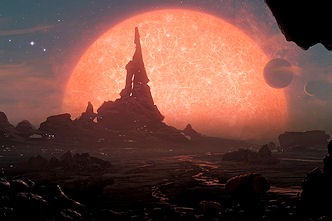
Tidally-locked planets
orbiting close to the red dwarfs could harbour stable habitable zones
(3), and the considerable longevity of the red dwarfs themselves offers
ample opportunity for the evolution of complex life (4). So,
perhaps it is little surprise that the SETI Institute has decided to
target selected red dwarf systems for signs of artificial radio
emissions (5).
"Astrobiologists had assumed that red dwarfs
put out too little light to support life on alien planets, but that was
before astronomers started finding Earth-sized worlds in close orbits
around distant stars. Now its thought that 6 percent or more of all red
dwarfs have potentially habitable, Earth-sized planets.
"Another plus for the prospects of red-dwarf
life is that such stars are amazingly long-lived: Astronomers have
already detected a super-Earth known as Kapteyn b that orbits an 11.5
billion-year-old red dwarf. That makes the star and the planet 2.5 times
older than Earth. "This may be one instance in which older is
better,” SETI Institute astronomer Seth Shostak said. “Older solar
systems have had more time to produce intelligent species."
(5)
It may eventually turn out that dwarf systems, both red and brown, are more stable environments for the longterm development of life than most mainstream stars like the Sun.
Written by Andy Lloyd,
References:
1) Jérémy Leconte et al. "Asynchronous rotation of Earth-mass planets in the habitable zone of lower-mass stars" Science, 347: 6222, 632-635, 6 February 2015
2) Christopher Crockett "Rocky planets around cool stars may have Earthlike climates" 15 January 2015
3) Adam Hadhazy "'Water-Trapped' Worlds: Life Around a Cool Star" 25 July 2013
4) Charles Choi "Planets Orbiting Red Dwarfs May Stay Wet Enough for Life" 17 February 2015
5) Alan Boyle "SETI Institute launches radio search for alien life amid 20,000 red dwarf stars" 30 March 2016, with thanks to Lee
Conference in Watford, England in July
I will be speaking at the "Awake and Aware Disclosure Summit", a weekend conference co-organised by Kerry Cassidy of Project Camelot and UFO Academy. It'll take place near Watford on Sunday 10th July 2016. Kerry, Peter Paget and Richard Alan Miller are also on the bill as speakers. The location is the delightful High Elms Manor, which featured in the hit TV series Country House Rescue some years ago here in the UK.

I'll be talking about Planet X, naturally enough. I'll be discussing all the latest findings coming out of the astronomical community regarding Planet Nine, and how this proposed body dovetails with the decades-old work of author Zecharia Sitchin. There are clearly huge implications for UFO-related research in the offing!

You can keep informed of updates by following me on Twitter:
![]()
Or like my Facebook Page: https://www.facebook.com/darkstarandylloyd